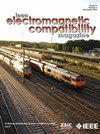Performance Assessment of Grounding System for Large-Scale Grid-Connected-Photovoltaic System Using the PEEC-MTL Hybrid Model
IF 2
3区 计算机科学
Q3 ENGINEERING, ELECTRICAL & ELECTRONIC
IEEE Transactions on Electromagnetic Compatibility
Pub Date : 2025-01-17
DOI:10.1109/TEMC.2024.3501369
引用次数: 0
Abstract
This article proposes an efficient and refined simulation method combining partial-element-equivalent-circuit (PEEC) and multiple-transmission-line (MTL) model considering the effects of lossy ground to develop a large-scale grid-connected photovoltaic (PV) system. The concentrated complex wire-conductor structure, such as PV panels, dc line of PV, grounding grids, and power distribution towers, are modeled using PEEC, while the long-distance transmission lines, such as buried cables and overhead lines are modeled with MTL. Both the ac side and dc side of the system are simulated synchronously, and the influence of the ac system on the dc system, including surge protecting device (SPD) installation, and grounding configurations are discussed. It is noted that a direct lightning strike on the dc side poses a significant threat to the system. However, when considering the connection to the ac system, the risk of lightning-caused overvoltage is mitigated. Moreover, this overvoltage reduces as the number of PV panels increases. For safe operation, it is essential to incorporate grounding at both ends of the cable enclosure and establish equipotential bonding among various grounding electrodes.基于PEEC-MTL混合模型的大型光伏并网系统接地系统性能评估
本文提出了一种结合部分单元等效电路(PEEC)和多路在线输电(MTL)模型的高效、精细的模拟方法,考虑了有耗地的影响,用于开发大型光伏并网系统。光伏板、光伏直流线路、接地网、配电塔等集中复杂导线结构采用PEEC建模,长距离输电线路如埋地电缆、架空线路采用MTL建模。对系统的交流侧和直流侧进行同步仿真,讨论了交流系统对直流系统的影响,包括防雷装置的安装和接地配置。值得注意的是,直流侧的直接雷击对系统构成重大威胁。然而,当考虑到与交流系统的连接时,雷击引起过电压的风险就降低了。此外,这种过电压随着光伏板数量的增加而减少。为了安全运行,电缆外壳两端均应接地,各接地电极之间应建立等电位连接。
本文章由计算机程序翻译,如有差异,请以英文原文为准。
求助全文
约1分钟内获得全文
求助全文
来源期刊
CiteScore
4.80
自引率
19.00%
发文量
235
审稿时长
2.3 months
期刊介绍:
IEEE Transactions on Electromagnetic Compatibility publishes original and significant contributions related to all disciplines of electromagnetic compatibility (EMC) and relevant methods to predict, assess and prevent electromagnetic interference (EMI) and increase device/product immunity. The scope of the publication includes, but is not limited to Electromagnetic Environments; Interference Control; EMC and EMI Modeling; High Power Electromagnetics; EMC Standards, Methods of EMC Measurements; Computational Electromagnetics and Signal and Power Integrity, as applied or directly related to Electromagnetic Compatibility problems; Transmission Lines; Electrostatic Discharge and Lightning Effects; EMC in Wireless and Optical Technologies; EMC in Printed Circuit Board and System Design.

 求助内容:
求助内容: 应助结果提醒方式:
应助结果提醒方式:


